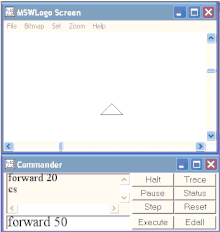Logo (programming language)
Logo is a high-level programming language, partly functional, partly structured; very easy to learn, which is why it is usually the preferred programming language for working with children and young people. It was designed for teaching purposes by Wally Feurzeig, Seymour Papert, and Cynthia Solomon, who drew on the features of the Lisp language. It was created for the purpose of using it to teach programming and can be used to teach most major programming concepts as it provides support for list, file and input/output handling. It has several versions.
Papert developed an approach based on his experience with Piaget in the early 1960s. Fundamentally, it consists of presenting children with intellectual challenges that can be solved by developing programs in Logo. The process of manually reviewing errors helps the child develop metacognitive skills by putting self-correcting processes into practice. He is known for being able to handle turtle graphs, lists, files, and recursion with ease.
Logo is one of the few programming languages with instructions in Spanish in some interpreters, among them: FMSLogo, LogoWriter, WinLogo, Logo Gráfico, XLogo, MSWLogo and LogoEs. Logo has over 180 interpreters and compilers, as listed in the "Logo Tree" project.
XLogo, MSWLogo and LogoES have the particularity of also being free software.
Language
One more exploited feature of Logo is being able to produce "turtle graphics", that is, being able to give instructions to a virtual turtle, a graphic cursor used to create drawings, which in some versions is a triangle, in others it has the shape of a turtle seen from above. This turtle or cursor is handled by words that represent instructions, for example:
English
forward 100 (the turtle walks forward 100 Steps)Right. 90 (the turtle turns to the right 90o)turnleft 30 (the turtle turns to the 30th left)Spanish
progress 100Turn right 90left 30The fact that instructions can be understood in different languages is what makes Logo such an easy programming language to learn. A sequence of instructions in Logo can be built into a rudimentary program, used as a block. This modular and reusable nature of the instructions makes Logo very flexible, recursive, and suitable for working in modules.
Other basic instructions of Logo in Spanish are:
- cs or BP: delete screen.
- rep or REPITE (number of times) [ (action) (quantity) ] e.g. -repite 4 [ av 100 gd 90], this repetition creates a square.
- st or MT: show turtle.
- ht or OT: hide turtle.
- pu or SP (no pen): up pencil, makes the turtle not draw while walking.
- pd or CP (with pen): down pencil, does the opposite of "-pu" ("SP" in Spanish interpreters).
The basic displacement instructions vary from one version of LOGO to another, being able to find as equivalents: DE, DERECHA, GD, for example, to indicate a clockwise rotation.
Contenido relacionado
Zero player game
Maximum transfer unit
Pc


